Are you planning on taking your cat on a long trip? Well, one of the questions you might have asked yourself is, ‘how long can cats hold their poop?’
As a responsible pet parent, it’s important to understand how often your cat poops. That knowledge will help you to monitor your cat throughout the trip and avoid messy accidents while he’s in his carrier.
Every cat is adorable, there’s no doubt about that. But the sight of a cat covered in poop is anything but attractive. Not to mention the choking smell that cat poop exudes. If this happens in your car in the middle of a hot afternoon, well, you get the picture. So, how long can a cat hold his poop?
There’s no cut-and-dried answer to the question ‘how long can cats go without litter box?’ The duration depends on several factors, including the animal’s age, diet, stress levels, activity levels, and overall health condition. While some cats can poop up to three times a day, others do it once a day or even once every other day.
Is Pooping The Only Thing To Worry About?
Cat poop isn’t the only thing you need to worry about when planning a long road drive with your kitto. You should also be concerned about how long your cat takes to pee. Just like cat poop, cat pee can smell really awful.
In this post, we describe everything there is to know about cats’ bowel and bladder movements. Some of the areas we’ll cover include how long cats can take to poop and pee, and when that duration should be a concern to any pet parent. We’ll also share insights on what you can do to regularize your cat’s bowel and bladder activity.
Table of Contents
How Often Do Cats Pee and Poop?
According to Richard Goldstein of the Cornell University of Veterinary Medicine, a normal cat can also poop between 1 and 3 times a day. He recommends seeking veterinary help if your cat goes for more than a day or two without defecating.
So, is it normal for a cat not to poop every day?
No, it’s rather abnormal for your feline friend to go a day without pooping.
Another key thing to note is what constitutes normal cat poop.
According to veterinary officers, normal cat poop should come out comfortably. There shouldn’t be noticeable signs of strain as that could indicate a problem with the cat’s diet or health.
Normal cat poop should also be brownish and well-formed, typically sausage-shaped. Sausage-shaped poop indicates that the cat is consuming the right diet and has a healthy digestion too.
Lastly, cat poop shouldn’t exude uncharacteristic odor. The smell of healthy cat poop should be mild and barely noticeable, unless the poop is in a confined space like inside your car.
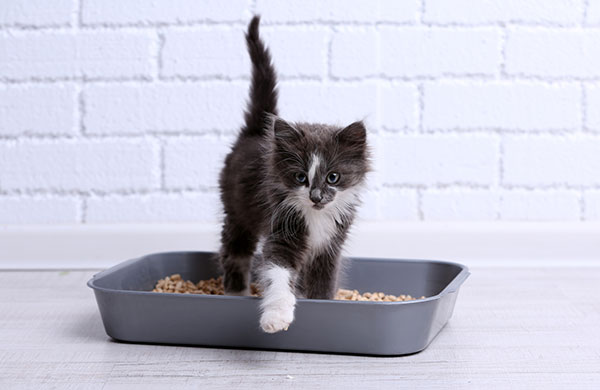
How often should cats poop & what factors could make your cat poop abnormally more or less frequent?
As we’ve already highlighted, a normal cat may poop between once and thrice a day. However, the duration could be shorter or longer, depending on the following factors;
i. Age
Kittens generally poop more often than mature and senior cats.
ii. Diet
Some cat foods can cause laxative effects, leading to diarrhea and more frequent bowel activity. Other foods can harden stool, causing constipation and less frequent bowel movements.
Another aspect of diet is the portions consumed. Generally, a cat will poop more frequently if he eats too much.
iii. Stress levels
Stress can mess up your cat’s bowel and bladder movements. Stressed cats could either develop diarrhea or constipation.
Common cat stressors include uncomfortable sounds like thunderstorms and fireworks, and unfamiliar sights like a new family member (human or pet).
Stress could also result from a full-blown anxiety disorder. Examples include obsessive-compulsive disorder (OCD), post-traumatic stress disorder (PTSD), social anxiety disorder (SAD), and separation anxiety.

iv. Routine disruptions
Cats are creatures of habit. A subtle disruption in their routine is all it takes to throw them off balance.
Examples of routine changes that could impact your cat’s bowel activity include;
- Moving homes
- Home renovation
- Traveling
- Changes in the cat’s feeding hours
- Changes in the cat’s sleeping area
v. Activity levels
Higher activity levels translate to a higher rate of metabolism and digestion. So, playful cats tend to poop more often than inactive cats.
vi. Health condition
Certain medical conditions and injuries might cause your cat to poop abnormally more or less frequently.
That’s especially true for diseases or injuries affecting the animal’s gut, such as intestinal blockage.
- High protein cat food dry formula with real chicken as the first ingredient
- Natural with prebiotic fiber nourishes specific intestinal bacteria for digestive health
- Wholesome cat food dry kibble with vitamin A and Omega-6 fatty acids to nourish skin and coat
Last update on 2024-10-18 / Affiliate links / Images from Amazon Product Advertising API
When Should I Be Worried?
It’s not uncommon to come across a cat owner wondering, ‘what is considered normal peeing and pooping for cats?’
To reiterate, cats should poop between 1 and 3 times a day and pee up to five times a day under normal circumstances. If your cat’s bowel and bladder activity doesn’t fall within this ‘normal’ range, then you have all the reasons to be worried.
According to veterinary health professionals, the following are common signs related to bowel activity in cats, which could indicate the animal is suffering from a severe medical condition;
- A cat pooping more than 5 times a day
- A cat going more than 3 days without pooping
- Refusal to eat or drink
- Straining in the litter box
- Crying out as if in pain while defecating
- Blood in stool
- Mucous in stool
- Too much fur in stool
- Overly loose or hard stool
- Uncharacteristic stool color and/or smell
- Nausea and vomiting
- Diarrhea
Constipation in Cats
As a caring and responsible pet parent, you must have often wondered, ‘why can’t my cat pee or poop?’
Constipation is the most common reason your cat might not be pooping as regularly as he should. Constipation in cats occurs when bowel activity becomes less frequent.
Numerous factors can cause constipation in cats, including too much dry or low-fiber foods, not enough water, stress levels, and routine changes. Constipation could also be a symptom of an underlying medical condition.

The best way to tell that your cat is constipated is if his litter tray remains empty for an abnormally long duration. When the urge to go comes, the stool may be painfully difficult to pass. And if the cat manages to pass the stool, you’ll realize that the poop appears hard, cracked, and lumpy. Sometimes, stool from constipated cats may be stained in blood.
Constipation can be a serious problem for cats, especially kittens and senior cats. If untreated, the condition can degenerate into obstipation or megacolon. Therefore, it’s recommended to seek veterinary help as soon as you realize your cat is constipated.
There are also a number of home remedies you can apply to ease constipation in cats as you prepare to take your kitto for a veterinary checkup.
For instance, you can try feeding the cat lots of fluids. But since a constipated cat has possibly lost his appetite too, plain water may not suffice. Instead, you can consider vegetable soup.
Besides feeding constipated cats enough fluids, you can also implement certain lifestyle changes to help relieve constipation.
Examples include;
- Changing the cat’s diet, focusing on wet and fiber-rich foods
- Managing the animal’s stress levels
- Going slow on routine changes
- Exercising your cat regularly to keep his weight in check
- Experimenting with a few over-the-counter laxatives, such as Miralax (PEG 3350) and Colace (docusate)
- Better Health for your Best Friend: Whether your cat has always struggled with digestion issues, or just needs a little extra help...
- Ultra-Concentrated Cat Probiotics: Our cat probiotics for diarrhea and vomiting is a custom treatment formulated with twenty...
- None of the Bad Cat Stuff: Don't fall for foreign-manufactured cat probiotics and digestive enzymes that use sugar, grain...
Last update on 2024-10-18 / Affiliate links / Images from Amazon Product Advertising API
There are also numerous natural remedies you can use to treat constipation in cats.
Examples include;
- Pureed pumpkin
- Ginger
- Vetasyl
- Probiotics
- Organic oils, such as castor oil, coconut oil, olive oil, and sunflower oil
Most importantly, remember to consult your vet before applying any home remedy to constipated cats. If you’re ever in doubt, take the animal for checkup immediately. Otherwise, you might only aggravate his condition instead of relieving it.
Diarrhea in Cats
Diarrhea is the exact opposite of constipation. But just like constipation, diarrhea in cats can result from a range of possible causes. Examples include dietary changes, food allergies, and underlying medical conditions.
Occasional bouts of diarrhea shouldn’t be a cause for concern as the condition usually clears up within 24 hours. However, you should be worried if the symptoms last more than 24 hours.
Watery stool is the most common symptom of diarrhea. The stools also tend to be lighter in color.
Other symptoms include;
- Blood in stool
- Vomiting
- Lethargy
- Hunched posture due to a painful abdomen
- Significant changes in a cat’s eating and drinking habits
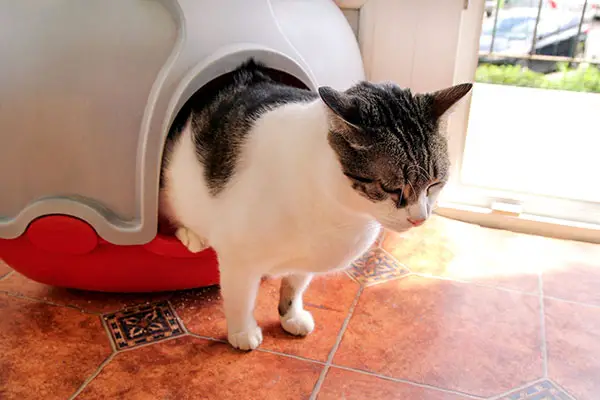
How Long Is Too Long For Cat Travel With No Bathroom Break?
We already pointed out traveling as one of the major routine changes that could interfere with your cat’s bowel activity. But this unpleasant fact shouldn’t deter you from bringing your cat with you on a road drive.
It’s only natural to be worried that your cat’s bathroom visits might ruin your trip. However, it’s reassuring to note that there are numerous tips you can implement to avoid poopy situations while traveling with your feline friend.
First and foremost, ensure you carry your cat’s litter box. Also, stop feeding the cat about 4 – 6 hours before the trip. You might also consider replacing your cat’s regular food with pet snacks.
The following are other tips to avoid dealing with cat poop while traveling;
✔ Carry pet diapers and wipes, as well as disposable bags
✔ Bring some motion sickness meds
✔ Take regular bathroom breaks (typically after every 2 – 3 hours)
✔ Bring some toys to keep your cat distracted while driving
What if your cat is not pooping after travelling?
Travel-induced stress and anxiety can affect your cat even after the trip is over. The cat may refuse to use the bathroom up to 24 hours or more after the trip.
It’s important to take immediate action as this could lead to constipation. Better yet, you can call your vet and let them know about your cat’s situation before things slip out of hand.
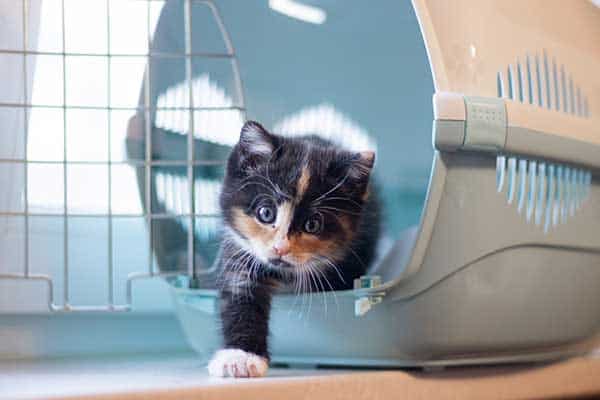
How Long Can Cats Hold Their Pee?
Regular bladder activity is just as important as regular bowel movements. So, it’s equally important to monitor your cat’s bladder movements.
Generally, cats should pee between 3 and 5 times a day. If your cat doesn’t pee for 24 hours, the toxins in his urine could enter his bloodstream and make him ill. The situation can be life-threatening if the cat goes for up to 48 hours without peeing.
So, if you’re planning to travel with your cat, it’ advisable to not let him drink. That’s because travel anxiety could make the animal retain his urine instead of expelling it, leading to medical issues. If you must give your kitto some water before embarking on a long trip, ensure you carry his litter box.
- Perfect for Big Cats and Multi-Cat Homes: The Modkat XL Litter Box is designed for large cats and households with multiple feline...
- Versatile Entry Options to Suit Every Cat: Configure as a top-entry to keep floors clean and minimize spillage, or use as a...
- Walk-Off Lid Keeps Your Floors Clean: The top-entry lid doubles as a walk-off mat, effectively catching stray kernels to keep your...
Last update on 2024-10-18 / Affiliate links / Images from Amazon Product Advertising API
The following are major factors that could interfere with your cat’s regular bladder activity and make him pee abnormally less or more frequent;
- Age – Kittens and elderly cats may not hold their urine for too long due to their weak bladder
- Diet – Drier or salty foods diminish urine production
- Not drinking enough water or fluids
- Stress levels – High stress levels could trigger over-urination or urine retention
- Routine changes – Sudden routine changes can make your cat pee too frequently or not frequently enough
- Activity levels – Active cats lose moisture from their bodies by various means like sweating; hence, they don’t pee too frequently.
- Urinary blockage
- Injury, especially one that affects a cat’s urinary system
- Certain medical conditions, such as kidney stones, diabetes, urinary tract infection, Lower Urinary Tract Disease (FLUTD), and cystitis (bladder inflammation)
A cat could also refuse to pee just because of sheer dislike for his litter box.
Most cats demonstrate a dislike for new litter boxes. Cats also generally dislike litter boxes that are too dirty or smelly.
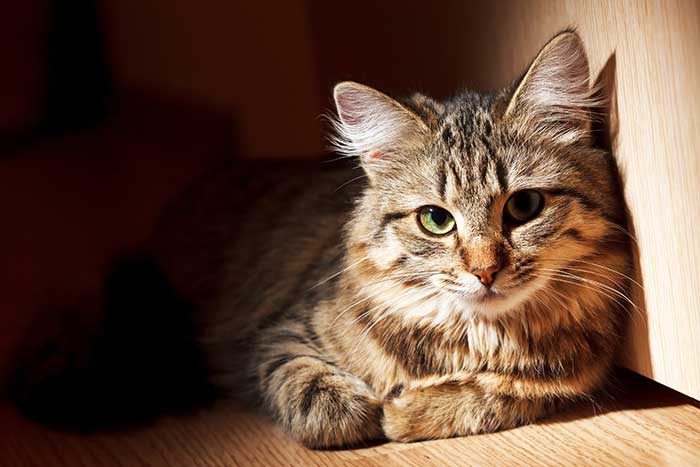
What do I do when my cat can’t pee or poop?
It’s recommended to consult your vet immediately you realize that your cat isn’t pooping as frequently as he should.
There are also certain home remedies you can apply to relieve mild bladder issues. One such remedy is the Ragdoll technique which involves gently squeezing a cat’s bladder.
Here’s a procedure for performing the Ragdoll technique;
i. Grab your cat by his armpit up to where his legs hang over the litter box.
ii. Find the cat’s bladder, usually located at the bottom of his rib cage, near his tail, or in the middle of his body.
iii. Squeeze the bladder gently while pressing the cat down.
Besides the Ragdoll technique, the following are other home remedies for relieving bladder issues;
- Parsley leaf for diuretic effects
- Cranberries for fighting urinary tract infection
- Marshmallow root for smoothing bodily irritations and fighting bacterial infections
- AUTOMATICALLY REMOVES WASTE: No scooping, cleaning or refilling your cat's litter box for weeks
- UNBEATABLE ODOR CONTROL: Crystal litter removes smell by absorbing urine and dehydrating solid waste
- NO MORE MESSY FLOORS: Low-tracking crystals are 99% dust free and don’t stick to your cat’s paws
Last update on 2024-10-17 / Affiliate links / Images from Amazon Product Advertising API
Other Frequently Asked Questions About Cats’ Bowel and Bladder Activity
Can cats hold their poop overnight?
Yes. Most cats generally poop once a day. So, it’s only logical to conclude that they can hold their poop overnight.
Do cats need a litter box at night?
This depends. Most cats can comfortably hold their poop overnight. Therefore, they would not need a litter box for pooping during the night.
However, it’s difficult for cats to hold their urine overnight. So, they would need a litter box to pee in one way or another.
How long can kittens hold their poop?
Kittens poo a lot more frequently than mature cats. Most kittens can hold their poo for around eight hours.
How long can kittens hold their pee?
Cats generally pee more often than they poo. Kittens can hold their pee for around 5 hours.
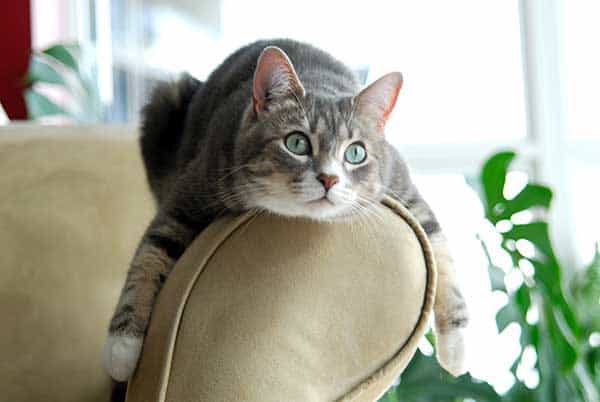
Conclusion
The answer to the question ‘how long can cats hold their poo and pee’ isn’t always clear cut.
As we’ve highlighted throughout this post, the duration it takes for a cat to hold his poo or pee depends on a number of factors. Examples include age, diet, activity levels, stress levels, routine disruptions, and certain medical conditions.
Regardless of the cause, it’s advisable to seek professional help as soon as you detect significant changes in your cat’s bowel or bladder activity.
Checkout Our Favorite Cat Products
1. Best Online Course For Cat Parents
Our favorite: The Cat Language Bible (How to Finally Understand And Speak to Your Cat) – A new form of cat to human communication that many cat owners have dreamed about… but few have actually thought possible.
2. Best Immune Support For Cats
Our favorite: Tomlyn Immune Support – Best Supplement for Cats and Kittens.
3. Best Cat Treats
Our favorites: LIFE ESSENTIALS All Natural Freeze Dried Chicken And Sheba Meaty Tender Sticks – Both are Great.






